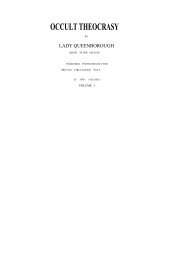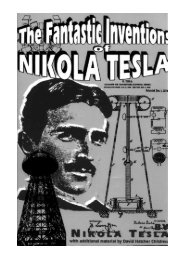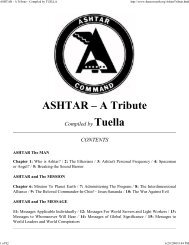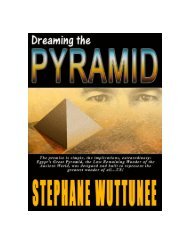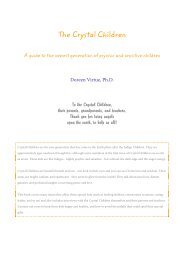the fantastic inventions of nikola tesla - Exopolitics Hong Kong
the fantastic inventions of nikola tesla - Exopolitics Hong Kong
the fantastic inventions of nikola tesla - Exopolitics Hong Kong
You also want an ePaper? Increase the reach of your titles
YUMPU automatically turns print PDFs into web optimized ePapers that Google loves.
or if, generally speaking, <strong>the</strong> bombardment on this side is weakened in some way or o<strong>the</strong>r, <strong>the</strong>re remains <strong>the</strong><br />
repulsion exerted upon <strong>the</strong> o<strong>the</strong>r, and <strong>the</strong> fan is set in rotation. The screening is best effected by fastening upon one<br />
<strong>of</strong> <strong>the</strong> opposing sides <strong>of</strong> <strong>the</strong> fan insulated conducting coatings, or, if <strong>the</strong> fan is made in <strong>the</strong> shape <strong>of</strong> an ordinary<br />
propeller screw, by fastening on one side, and close to it, an insulated metal plate. The static screen may, however,<br />
be omitted, and simply a thickness <strong>of</strong> insulating material fastened to one <strong>of</strong> <strong>the</strong> sides <strong>of</strong> <strong>the</strong> fan.<br />
To show <strong>the</strong> behavior <strong>of</strong> <strong>the</strong> coil, <strong>the</strong> fan may be placed upon <strong>the</strong> terminal and it will readily rotate when <strong>the</strong> coil is<br />
operated by currents <strong>of</strong> very high frequency. With a steady potential, <strong>of</strong> course, and even with alternating currents<br />
<strong>of</strong> very low frequency, it would not turn, because <strong>of</strong> <strong>the</strong> very slow exchange <strong>of</strong> air and, consequently, smaller<br />
bombardment; but in <strong>the</strong> latter case it might turn if <strong>the</strong> potential were excessive. With a pin wheel, quite <strong>the</strong> opposite<br />
rule holds good ; it rotates best with a steady potential, and <strong>the</strong> effort is <strong>the</strong> smaller <strong>the</strong> higher <strong>the</strong> frequency.<br />
Now, it is very easy to adjust <strong>the</strong> conditions so that <strong>the</strong> potential is normally not sufficient to turn <strong>the</strong> fan, but that<br />
by connecting <strong>the</strong> o<strong>the</strong>r terminal <strong>of</strong> <strong>the</strong> coil with an insulated body it rises to a much greater value, so as to rotate<br />
<strong>the</strong> fan, and it is likewise possible to stop <strong>the</strong> rotation by connecting to <strong>the</strong> terminal a body <strong>of</strong> different size, <strong>the</strong>reby<br />
diminishing <strong>the</strong> potential.<br />
Instead <strong>of</strong> using <strong>the</strong> fan in this experiment, we may use <strong>the</strong> "electric" radiometer with similar effect. But in this case<br />
it will be found that <strong>the</strong> vanes will rotate only at high exhaustion or at ordinary pressures; <strong>the</strong>y will not rotate at<br />
moderate pressures, when <strong>the</strong> air is highly conducting.<br />
This curious observation was made conjointly by Pr<strong>of</strong>essor Crookes and myself. I attribute <strong>the</strong> result to <strong>the</strong> high<br />
conductivity <strong>of</strong> <strong>the</strong> air, <strong>the</strong> molecules <strong>of</strong> which <strong>the</strong>n do not act as independent carriers <strong>of</strong> electric charges, but act all<br />
toge<strong>the</strong>r as a single conducting body. In such case, <strong>of</strong> course, if <strong>the</strong>re is any repulsion at all <strong>of</strong> <strong>the</strong> molecules from<br />
<strong>the</strong> vanes, it must be very small. It is possible, however, that <strong>the</strong> result is in part due to <strong>the</strong> fact that <strong>the</strong> greater part<br />
<strong>of</strong> <strong>the</strong> discharge passes from <strong>the</strong> leading-in wire through <strong>the</strong> highly conducting gas, instead <strong>of</strong> passing <strong>of</strong>f from <strong>the</strong><br />
conducting vanes.<br />
In trying <strong>the</strong> preceding experiment with <strong>the</strong> electric radiometer <strong>the</strong> potential should not exceed a certain limit, as<br />
<strong>the</strong>n <strong>the</strong> electrostatic attraction between <strong>the</strong> vanes and <strong>the</strong> glass <strong>of</strong> <strong>the</strong> bulb may be so great as to stop <strong>the</strong> rotation.<br />
A most curious feature <strong>of</strong> alternate currents <strong>of</strong> high frequencies and potentials is that <strong>the</strong>y enable us to perform<br />
many experiments by <strong>the</strong> use <strong>of</strong> one wire only. In many respects this feature is <strong>of</strong> great interest.<br />
In a type cf alternate current motor invented by me some years ago I produced rotation by inducing, by means <strong>of</strong> a<br />
single alternating current passed through a motor circuit, in <strong>the</strong> mass or o<strong>the</strong>r circuits <strong>of</strong> <strong>the</strong> motor, secondary currents,<br />
which, jointly with <strong>the</strong> primary or inducing current, created a moving field <strong>of</strong> force. A simple but crude form<br />
<strong>of</strong> such a motor is obtained by winding upon an iron core a primary, and close to it a secondary coil, joining <strong>the</strong><br />
ends <strong>of</strong> <strong>the</strong> latter and placing a freely movable metal disc within <strong>the</strong> influence <strong>of</strong> <strong>the</strong> field produced by both. The<br />
iron core is employed for obvious reasons, but it is not essential to <strong>the</strong> operation. To improve <strong>the</strong> motor, <strong>the</strong> iron<br />
core is made to encircle <strong>the</strong> armature. Again to improve, <strong>the</strong> secondary coil is made to overlap partly <strong>the</strong> primary,<br />
so that it cannot free itself from a strong inductive action <strong>of</strong> <strong>the</strong> latter, repel its lines as it may. Once more to improve,<br />
<strong>the</strong> proper difference <strong>of</strong> phase is obtained between <strong>the</strong> primary and secondary currents by a condenser, selfinduction,<br />
resistance or equivalent windings.<br />
I had discovered, however, that rotation is produced by means <strong>of</strong> a single coil and core; my explanation <strong>of</strong> <strong>the</strong><br />
phenomenon, and leading thought in trying <strong>the</strong> experiment, being that <strong>the</strong>re must be a true time lag in <strong>the</strong> magnetization<br />
<strong>of</strong> <strong>the</strong> core. I remember <strong>the</strong> pleasure I had when, in <strong>the</strong> writings <strong>of</strong> Pr<strong>of</strong>essor Ayrton, which came later to<br />
my hand, I found <strong>the</strong> idea <strong>of</strong> <strong>the</strong> time lag advocated. Whe<strong>the</strong>r <strong>the</strong>re is a true time lag, or whe<strong>the</strong>r <strong>the</strong> retardation is<br />
due to eddy currents circulating in minute paths, must remain an open question, but <strong>the</strong> fact is that a coil wound<br />
upon an iron core and traversed by an alternating current creates a moving field <strong>of</strong> force, capable <strong>of</strong> setting an<br />
armature in rotation. It is <strong>of</strong> some interest, in conjunction with <strong>the</strong> historical Arago experiment, to mention that in<br />
lag or phase motors I have produced rotation in <strong>the</strong> opposite direction to <strong>the</strong> moving field, which means that in that<br />
experiment <strong>the</strong> magnet may not rotate, or may even rotate in <strong>the</strong> opposite direction to <strong>the</strong> moving disc. Here, <strong>the</strong>n,<br />
is a motor (diagrammatically illustrated in Fig. 17), comprising a coil and iron core, and a freely movable copper<br />
disc in proximity to <strong>the</strong> latter motor and generator being insulated in space. To produce rotation it is generally (but<br />
not absolutely) necessary to connect <strong>the</strong> free end <strong>of</strong> <strong>the</strong> motor coil to an insulated body <strong>of</strong> some size. The experimenter's<br />
body is more than sufficient. If he touches <strong>the</strong> free terminal with an object held in <strong>the</strong> hand, a current<br />
passes through <strong>the</strong> coil and <strong>the</strong> copper disc is set in rotation. If an exhausted tube is put in series with <strong>the</strong> coil, <strong>the</strong><br />
tube lights brilliantly, showing <strong>the</strong> passage <strong>of</strong> a strong current. Instead <strong>of</strong> <strong>the</strong> experimenter's body, a small metal<br />
sheet suspended on a cord may be used with <strong>the</strong> same result. In this case <strong>the</strong> plate acts as a condenser in series with<br />
<strong>the</strong> coil. It counteracts <strong>the</strong> self-induction <strong>of</strong> <strong>the</strong> latter and allows a strong current to pass. In such a combination, <strong>the</strong>



